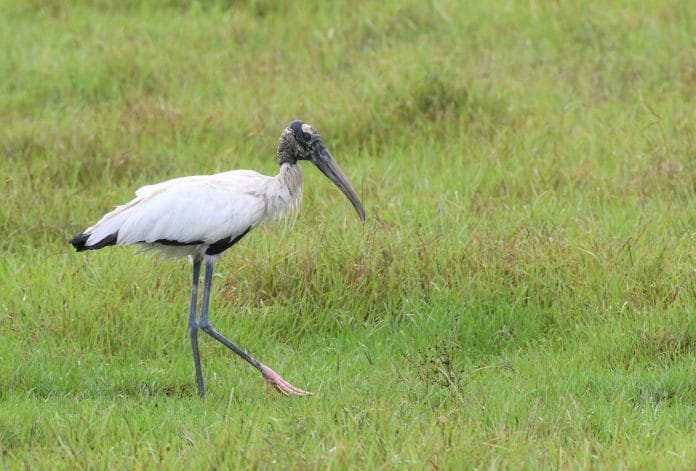The Wood Stork is a very strange looking bird found in Florida. The head lacks feathers, it has long thin legs, black/white feathers, and pinkish feet! Although unusual looking, I have developed a fondness for this most remarkable species of wading bird. The Wood Stork was on the brink of extinction. In the 1970s there were only 5,000 pairs recorded. Loss of wetland habitats and food base were primary factors in the sudden decline. In the everglades, nesting failure was also a contributor. In 2014, the U.S. Fish and Wildlife Service reclassified the Wood Stork from “endangered” to “threatened”. In Florida, it is listed as “Federally-designated Threatened” and it is also protected under the U.S. Migratory Bird Treaty Act.
The Wood Stork’s primary diet is small fish, such as minnows and sunfish. If you see a Wood Stork with its beak in the water, it is hunting. This method of hunting is called tacto-location. The Wood Stork will hold its beak partially open and wait for a fish to touch it, then SNAP! According to the U.S. Fish and Wildlife Service, this rapid response is an astonishing 25 milliseconds. Wood Storks will also feed on crayfish, small amphibians, and reptiles.
In Central Florida, one might see nesting colonies from February to March. Males begin building nests, after mating. Nests are made up of twigs and small branches usually over water. Only two to five eggs are laid per clutch in a season. After hatching, baby Wood Storks can take flight at about 10 to 12 weeks. Storks reach breeding maturity at three years of age.
You can see Wood Storks in different wetland habitats. They can be found in mangrove swamps, flooded wetlands, and around small ponds. In Hernando County, I usually see them in cypress hammocks or flooded pastures containing a small creek or pond.
If you see Wood Storks on your property, consider yourself lucky. If you have large property, creating a favorable habitat would be ideal. For more information please visit: https://myfwc.com and search “Wood Stork” in the right-hand search bar.
Interesting fact: The Wood Stork is the only species of stork that breeds in the United States.
Extension programs are open to all persons without regard to race, color, sex, age, disability, religion, or national origin.

